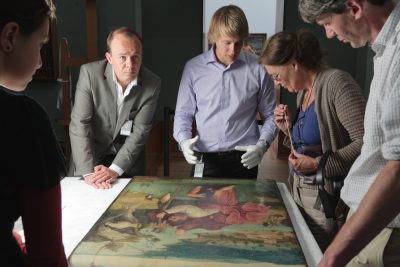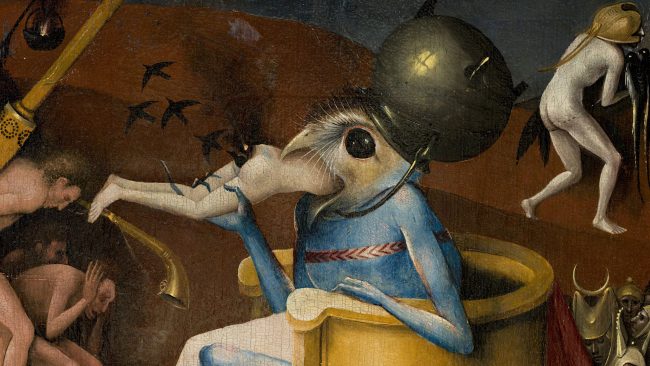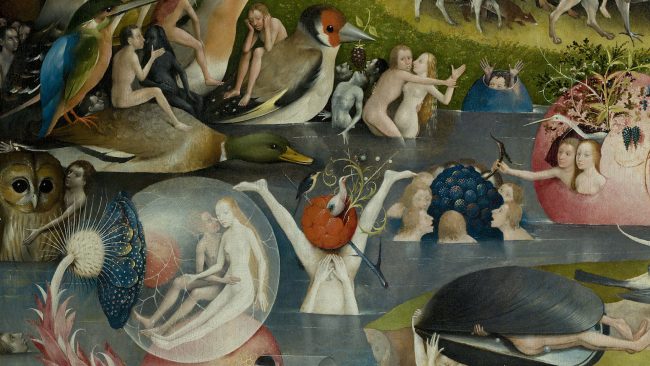The documentary Hieronymus Bosch: Touched by the Devil follows a team of art historians who try to reveal the mystery of the 25 extant paintings of Hieronymus Bosch.
Over the course of five years the research team travelled the world, visiting museums such as The Louvre, The Prado and the National Gallery of Art in Washington to make an in-depth analysis of Bosch’s paintings. By using modern techniques, such as X-ray, infrared photography, and multi-spectrum analysis, they allow us to penetrate into the deeper layers of his paintings thus helping the audience to look at the works of Bosch with new eyes.

The research raises the question whether all works are really painted by Bosch. The museum world is waiting anxiously for the results. Is their Bosch a real Bosch? In addition, The Noordbrabants Museum has organized the largest exhibition to date of the medieval painter in 2016 in Den Bosch, The Netherlands to commemorate the 500th anniversary of the artist’s death. The museum plays a political chess game to get as many paintings as possible to the exhibition. The Prado owns several masterpieces
and will organize their own exhibition on El Bosco. Will The Noordbrabants Museum manage to bring the masterpieces home to the Netherlands?
In March the reliably excellent New Yorker Magazine published this piece, HIERONYMUS BOSCH’S FIVE-HUNDREDTH-ANNIVERSARY HOMECOMING, by Becca Rothfeld. It begins:
“The Dutch city of ’s-Hertogenbosch is as unlike Hell as a place could be. A pleasant assemblage of canals, bikeways, and colorful buildings, it often seems to border on the heavenly, at least for a certain brand of bourgie millennial. Earlier this month, on the five-minute walk from the train station to my bright, modernist Airbnb, I encountered not one but two health-food shops, one of which specialized in artisanal yogurts. But quaint appearances notwithstanding, ’s-Hertogenbosch—known colloquially (and much more manageably) as Den Bosch—is also the birthplace and lifelong home of Hieronymus Bosch, the late medieval painter famed for his bloody, sensationalist depictions of Hell and its beastly denizens. Until this year, a bronze statue of the artist looming over the market square was the most visible sign that Bosch had once lived here. But this month, in honor of the five hundredth anniversary of his death, a major exhibition at the Noordbrabants Museum and several citywide celebrations of Bosch’s work have studded the innocuous landscape of his home town with tributes to the infernal bacchanals he depicted.

“Biographical details about Bosch’s life are famously scant, but we know that he was born Jeroen van Aken around 1450 and remained in Den Bosch until his death, in 1516. He came from a family of painters based in a workshop on the east side of the Markt, the central city square. (Today a sleepy town of around a hundred and fifty thousand residents, Den Bosch was at that time one of the Duchy of Brabant’s four capitals, and a bustling regional center.) When he wasn’t busy dreaming up abject sinners and vengeful devils, Bosch was performing mundane tasks like designing stained-glass windows, and, though he was one of the first painters in the Low Countries to sign his work, he probably considered himself more of an artisan than an artist.

“Yet despite the modest size of his oeuvre—his confirmed works consist of only two dozen panels and triptychs and a slightly smaller number of drawings—Bosch managed to exert an outsized influence on the religious imagery of his day. His fantastic demons, impossible amalgamations of animals, humans, monsters, and household objects, had little precedent in earlier devotional art, nor in the somewhat formulaic depictions of Heaven and Hell that prevailed among his contemporaries. Bosch’s hellscapes presented palpable pandemonium, and even his more routine works were enlivened by inventive details: a winged fish with an unfriendly expression following Christ across a river; a tottering demon protruding from a funnel. It wasn’t long before Bosch’s idiosyncrasies were incorporated into the medieval mainstream: some of his followers went so far as to work from “model sheets,” which provided stock images of the artist’s demons and ne’er-do-wells for workshops to copy. Centuries later, Bosch’s vision would inspire the nightmarish works of Surrealists like Odilon Redon and Max Ernst.”

Yes, for heaven’s sake, please do show this again! Those of us who were out of town during this scheduled showing would love to be able to see this fascinating film! Please do consider reshowing this! Also, help us understand why you can not reshow this film.
yes, yes please show this Bosch feature again…anytime! I will be there! I will drop everything and go to see this feature
Would you show again this interesting Hieronymus Bosch film?….This is the year to see his work and all that is happening in Holland ..please show it again at least one more time, I can drive for an hour if it is shown in Claremont…just show it once more please.
@ Laemmle Playhouse 7 in Pasadena: why do you put every single interesting movie you have only on Sat/Sun 11 am? Do you think everybody can drop everything and go to movies at 11am !?! Why don’t you reschedule at 11am some of all the utterly useless and boring comedies you place on every single evening of the week and weekends and schedule some decent movies at decent times? Would have loved to watch Hieronymus Bosch, like I would have loved to watch almost everything else that you stuck at these impossible morning times? Do you actually want customers?